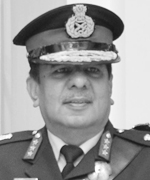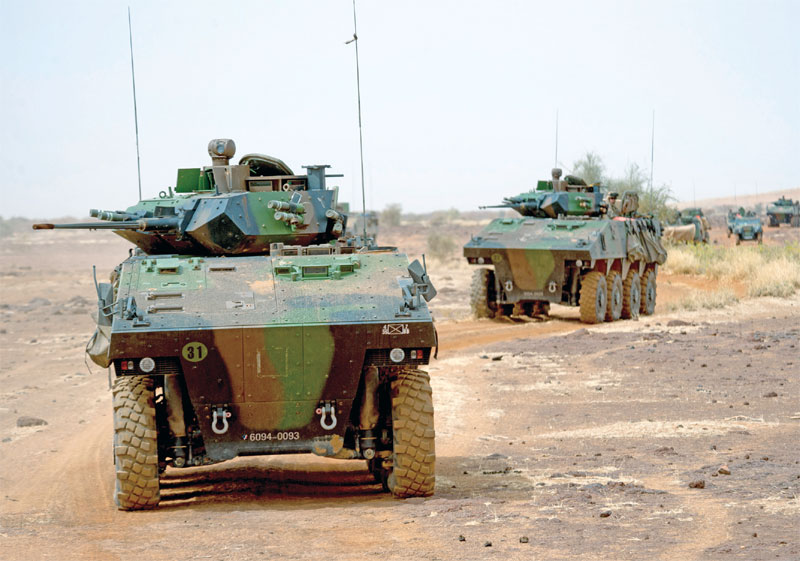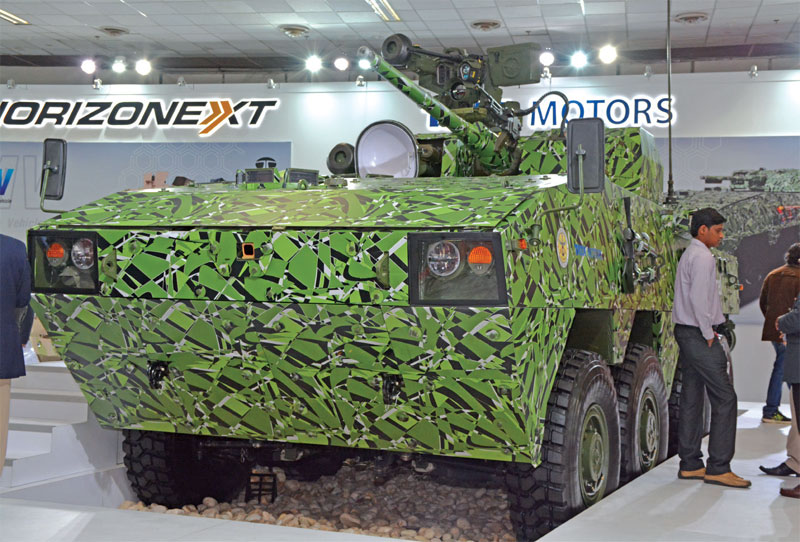There is a need to prioritise long delayed combat vehicles
 Lt Gen A B Shivane (retd)
Lt Gen A B Shivane (retd)
The recent retort to national security threats has witnessed the nation shedding the cloak of a soft state, and emboldened by decisive political will, demonstrated military capability and unambiguous strategic messaging. The new normal exhibits a policy of assured retribution with punitive military response capability for proxy war at a time and place of one’s own choosing, irrespective of the erstwhile self-imposed strategic restraints.
Similarly, the challenges of sporadic assertiveness and discerning calm on the Northern front poses concerns for the future, mandating a dissuasive deterrence capability in place. The future challenge, however, lies in adding teeth to this response matrix, bridging operational voids and building future capabilities in a time sensitive domain. The key to this is envisioning future threats, strategising response mechanisms and building matching capabilities, based on a ‘value, vulnerability and risk’ analysis in temporal terms.
Of course, all this will be in vain and ‘business as usual’, without the demonstrated will of the government to provide matching budgetary support, priority clearance of big-ticket defence projects by CCS, overcoming bureaucratic apathy and energising the defence industrial base. The policy makers must not be found wanting in their responsibilities and accountability of translating intents into outcomes.
The reality that must serve as a constant reminder to the nation is that, given our turbulent geo-strategic environment, intentions can change fast, but capability development and equipping future forces takes time. The security challenges of tomorrow will, thus, have to be met by the defence capabilities we develop today. The nation cannot be found wanting at the times of crisis. Indeed, ‘Nation Above All’ is the need of the hour.

Indian Army Future Ready Forces
It must never be forgotten that a nation with disputed and turbulent borders requires boot and tracks on ground. This is not to dilute but put in right perspective and priority the awed fashionable western terminologies of non-contact warfare, shadow wars and multi-domain warfare. Even in the ongoing proxy war focus, it must not be forgotten that the levers of making proxy war cost prohibitive, lie in generating a superior conventional punitive response capability.
To meet these challenges, the Indian Army is focusing on three key areas of operational readiness, force modernisation and structural transformation to prevail in today’s war and fight to win future wars. However, in the present environment finding ‘novel ways’ with ‘limited means’ to achieve ‘larger ends’ remains a challenge. The imperative, thus, is to restructure and refit a ‘big war military with smart, lean, agile combined arms joint warfare capabilities’. The focus is to develop a technology enabled, future ready, combined arms modular force, capable of decisive operations across the entire spectrum of conflict.
Thus, the need is for a rapid deployable force, to generate a superior mounting tempo and thereafter execute operations at an overwhelming execution tempo, to dominate the key operational factors of ‘Time-Space-Force-Information’. One such capability being generated is the Integrated Battle Group (IBG) concept, spearheaded by the mechanised forces. The rationale of mechanised forces spearheading these IBGs, lies in their basic characteristics of survivability, mobility, lethality and adaptability, across the entire spectrum of conflict.
Besides, wars are lost and won in the minds, and these brutal tank forces with their shock action, aid in strategic and operational dislocation of enemy forces, creating physical and physiological paralysis. Modernisation of the legacy fleet to bridge technology gap and simultaneous time sensitive induction of next generation platforms accordingly assumes operational necessity. It is, thus, imperative for the nation to generate capability for the mechanised forces to be future ready, technologically enabled and versatile instrument of deterrence in peace and a force of decision in war.
Desired Capabilities of Mechanised Forces
The desired capability mandate for the mechanised forces dwells on a few essentials:
- Deterrence capability based on medium class contemporary state-of-the-art next generation main battle tanks (MBTs) and Infantry Combat Vehicles (ICVs) essentially for western front and selectively for northern front.
- Lighter and versatile light tanks and wheeled ICVs for employment in marginal and high-altitude terrain where medium tanks cannot operate.
- Be the driver for the combined arms team in an essentially networked joint warfare battle space. Thus, their employment must be seen in the context of an enlarged mechanised forces canvas including attack helicopters, self-propelled artillery and self-propelled air defence besides other mobile combat support elements like combat armoured engineers, armoured signals and mobile logistics elements.
- 4th Generation Warfare environment and Hybrid War will mandate high survivability and critical capability to close-in, contain and neutralise these threats. Armoured Fighting Vehicles (AFVs) as mobile protected lethal platforms must generate this capability.
- Be the forerunner of indigenous technology induction through a spiral approach and a compeller for tri-service synergy. AFVs will invigorate development of defence industry base.
- Generate intrinsic capability to survive and operate under CBRN environment.
- Meet commitments of out of area contingencies and UN.
AFV Fleet Management Perspective
Future mechanised force modernisation will have to be built on the principles of retaining the capacity and readiness to accomplish combat overmatch, expanding new capabilities to deter and defeat emerging threats, and optimising force capabilities through a combined arms force application, in an essentially joint force application environment.
This capability generation in turn guides the Fleet Management Perspective (FMP). The framework of FMP accordingly focuses on a balanced approach of sustaining the present fleet, modernisation of legacy fleet and induction of next generation platform in a time sensitive domain. It also aims at balancing fleet expansion and fleet modernisation within pragmatic resource availability.
The pillars of this perspective, thus, must rest on five key aspects; sustain current fleet and address voids; upgrade legacy fleet to bridge technological gaps till replacement platforms; develop and induct next generation state-of-the-art replacement platforms; replace obsolete and beyond service life equipment progressively; and optimise indigenous capability for a spiral approach to technological challenges and defence production. One such capability which in the present environment remains sluggish and devoid of outcome, is the induction of next generation platforms.

Induction of Next Generation Platforms
The history of Future Infantry Combat Vehicle (FICV) and Future Ready Combat Vehicle (FRCV) is a saga of illusions and a case study of lethargic capability building and bureaucratic apathy, compromising future combat readiness and national security. Termed as game changers for an integrated defence ecosystem, both for infrastructure development and high technology infusion, under the otherwise illusive ‘Make in India’, it had raised optimism in the nascent yet vibrant Indian defence industry.
Ironically, these dream projects, particularly the FICV, seems to have crashed, in spite of all the recent positive policy initiatives and promises. Repeated procedural hiccups and lack of accountability for the project at apex level has resulted in more snakes than ladders in its turbulent case history which has become synonymous with defence procurement cycles. This has resulted in creating an operational void due to attendant time delay, escalating inflationary cost and uncertainty of assured budgetary support in the future.
The time is, however, never too late for expeditious actions to correct the anomalies and pave an institutionalised path for their outcomes. Both FRCV and FICV need to be institutionalised by the government as strategic defence capability projects with apex level monitoring, responsibility and accountability.
FICV: The FICV is a time critical replacement of obsolete BMP II (procured in mid-Eighties) which began its turbulent journey through an Acceptance of Necessity (AON) in Oct 2009, under DPP 2008 Make Chapter, for quantity 2610 combat vehicles. Since 2009, the Futuristic Infantry Combat Vehicle (FICV) project has been launched twice through Expression of Interest (EoI) in 2010 and later in 2015, each time with great promise, but wavering stance, commitment and lethargy at decision-making level. The last EoI of July 2015 was evaluated in an objective, transparent and fair manner and submitted after nine months of intense and tedious evaluation by the IPMT, for approval of the ministry of defence (MoD) in November 2016.
The impasse commenced with the same MoD office who had approved the EoI evaluation criteria, raising concerns on its approved parameters and weightages, at a stage when results were placed on file. This de-facto amounted to changing the goal-post after results were submitted with attendant and intended delays. The case was referred to a panel of independent expert monitors (IEMs) by MoD, who conclusively found the EoI evaluation righteous to be moved to the next stage of nomination of the development agencies (DAs).
Having presumably overcome these initial setbacks of over 30 months of decision paralysis, the new lot of approving authorities now developed cold feet on the budgetary allocation for development cost to the two private industry DAs (80 per cent by government and 20 per cent by DA under DPP 2008). Once again, those influential private players not in the fray seeing it as an opportunity raised yet another bogey to sabotage the case by recommending progressing it under Make 2 (DPP 2016), thereby enticing a fund-starved MoD to save its initial development cost.
Conveniently, the case was again put into a loop with no sense of time, accountability or direction. The result of the present quagmire is that the army continues to hold and produce an obsolete technology equipment on its operational inventory. Even if the FICV as planned based on the present Expression of Interest optimistically manifests in the army by 2026-27, the complete fleet replacement will be only completed earliest by 2040. Thus, any further delay in obviating this operational void will only be at the risk to national security.
It’s about time now to find a way ahead with a de novo look in the light of all options of Make1/Make2/SP not making a headway. The first and foremost critical aspect for progressing FICV is to have a demonstrated intent at the apex level, to develop the capability by all stakeholders. Secondly, the intent must be matched by an assured budgetary support based on benchmarks achieved and spread over the entire development cycle. Thirdly, the design and development of FICV must be done in India. Public-Private Partnerships could meet this challenge based on a model of collaboration rather than cut-throat competition.
Public–private is the principal way in which the private sector through financial investment, talent sharing, management skill transfer, joint ventures and provision of additional resources can join hands, optimising government assets like Ordnance Factory Board (OFB), wherein infrastructure and experience already exists. Even cost sharing could be based on a mutually agreed arrangement of risk sharing and gain sharing.
However, it must be ensured that the levers of comprehensive transfer of technology (ToT) and IPR rest with Indian firm. In general, PPP model for FICV will provide a strong impetus for technological innovation and outcome-oriented arrangement, wherein competition and associated negative trends, give away space for hand-holding collaboration and cooperation. For the FICV, the partnership model could be OFB as the principle integrator, with active participation in design and development by private defence industry/ DPSUs and their JVs, and Defence Research and Development Organisation (DRDO) as technology partner, all collaborating together. The necessary integration of academia could also be done. The government could play the role of a catalyst. Of course, it entails the risk of putting all your eggs in one basket, and thus, must have a fall-back option inbuilt.

FRCV: The FRCV as the next generation main battle tank is proposed to replace the vintage T-72 Tank Fleet (in service since 1979), which has progressively gone beyond its service life. Even if optimistically inducted in 2027, it will in all probability replace the entire T 72 fleet beyond 2040.
Unfortunately, the MBT Arjun MK II 68 tonne tank has not evolved into a suitable replacement platform for the Indian operational environment and thus, does not meet the user aspirations both in terms of its deployability and employability. The FRCV will also lend itself to development of a family of combat vehicles, based on modularity and standardisation of platform. Being a high technology complex platform, it would reinvigorate a defence ecosystem, besides induction of high technology and indigenisation in the defence industry.
The FRCV historical past is as turbulent as the FICV itself but hopefully the evolving future will be more progressive. It was planned to be developed under Make Project since 2008-09, however, seeing the tardy progress of other projects it was proposed as a de novo three stage turnkey project outside the DPP, directly under MoD. It entailed a competitive design selection, shortlisting of a developer for the chosen design and production under nominated production agency.
Accordingly, an RFI was floated in June 2015 for design agencies wherein a good response was received. However, with personality changes in service headquarters, decisions changed to shift the FRCV under MAKE 1 as the new DPP 2016 evolved and the case was progressed to MoD. Again, while under review at MoD, the flavour changed in favour of Strategic Partnership (SP) model which seemed rosy but remains a test case challenge with attendant ambiguities. Accordingly, an RFI was floated by Service Headquarters in November 2017 to solicitate response from foreign partners. The foreign original equipment manufacturers (OEM) are thereafter to team up with the nominated Indian partner selected by MoD through an EoI.
While the RFI responses are under finalisation, the approval of the PSQR by service headquarters and grant of Acceptance of Necessity (AoN) by MoD is being expedited. Subsequently, the empowered committee would issue the EoI with technology vectors to select the Indian strategic segment partner. The real dynamics and first critical benchmark of the case would commence with the final shortlisting of the Indian partner and establishing the relationship with foreign partner to respond to a concrete request for proposal. Thus, an institutionalised monitoring mechanism with approved funding needs to be in place prior to ensure all roadblocks are addressed and the project does not stall. It must be ensured that the case remains time sensitive and on course through an institutionalised Apex Project Monitoring Committee under the defence minister and FRCV Programme Management Team under Service Headquarters, with user central to all decisions.
The MoD must ensure that the evolving FRCV under the strategic partnership programme does not stall like its ill-fated FICV did under Make 1. DRDO and OFB in turn must facilitate in their expertise as technology partners and quality manufacturer respectively, rather than as lone rangers evolving isolated FRCV projects albeit with different names, in their own cocoons.
However, the back-up option of government-to-government procurement must be kept alive, provided the levers of comprehensive ToT including design ToT are in our hands, overcoming the present restrains of licenced production. In addition, a comprehensive life cycle management approach with focus on indigenous defence capability and a time sensitive manifestation, specific to Indian operational environment, is an imperative.
Concluding Thoughts
The Indian Army needs to focus on an integrated force generation matrix in keeping with future threats and desired capabilities. Mechanised forces as part of the IBG must get their due focus in the present force restructuring and capability building. The approach to future capability building must be inclusive and not exclusive, based on the larger intent of prevailing in today’s war and generating capabilities to fight and win future wars. FRCV and FICV programme are key strategic defence capability enablers, which merit apex level stake holding and must not be allowed to figure in the obituary columns of tomorrow.
(The writer retired as Director General Mechanised Forces)

